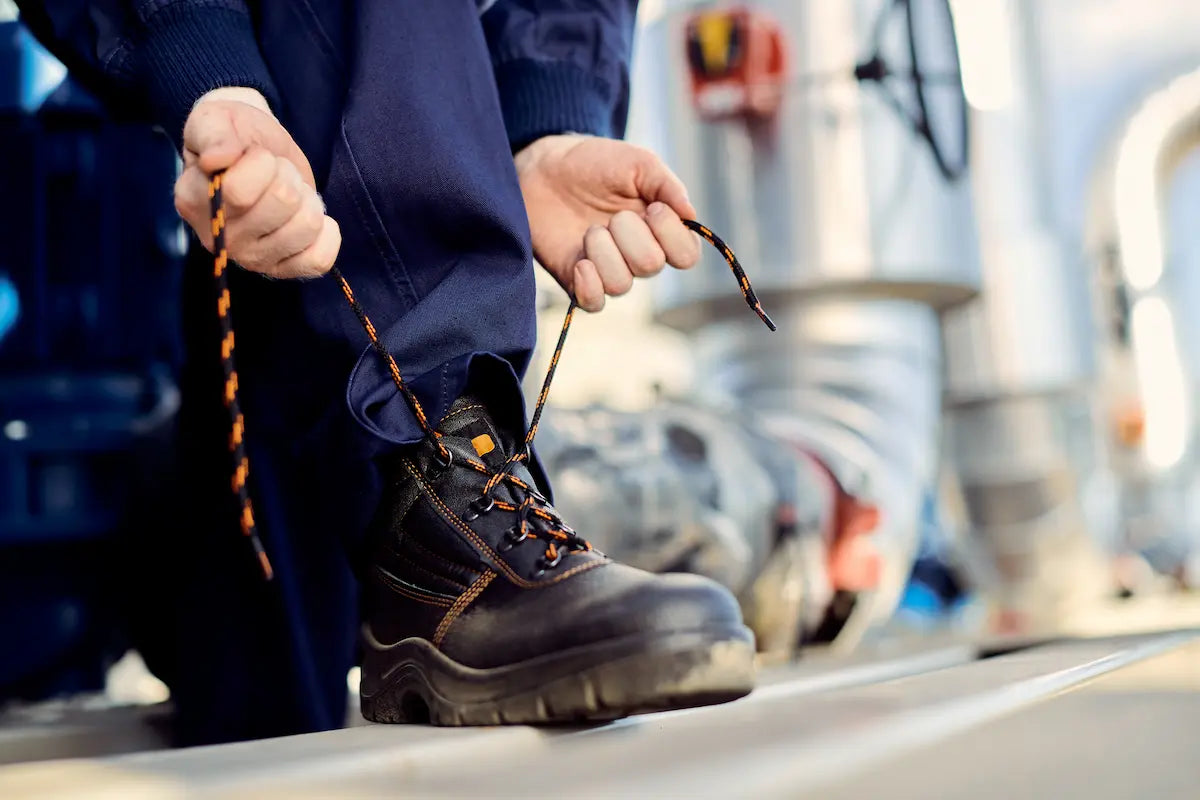Are you stepping into a hazardous environment or job site with nothing but your everyday shoes? Hold up! Your feet deserve better than that. Whether you're in construction, manufacturing, or any industry where hazards lurk, your feet need adequate protection, and that goes for your feet, too. It's a no-brainer.
But how do you decipher those cryptic safety labels on work boots? Has the alphabet soup of acronyms left you scratching your head in search of answers? In this comprehensive guide to safety footwear standards and regulations, we'll decode those safety footwear labels, ensuring you stride confidently into the workplace, equipped to tackle whatever may come your way. Literally.
Safety first, right?
What Are the Safety Requirements for Work Boots?
Before we dive into the nitty-gritty of safety labels, let's understand why they're there in the first place. Safety recommendations are about more than just checking boxes. Safety footwear regulations are the cornerstone of workplace safety, ensuring that every step you take is a secure one.
Safety requirements for work boots are like armor for your feet, crafted to keep you from harm's way. They shield you from sharp objects, heavy materials, electrical shocks, slips and falls, and a barrage of other potential workplace hazards. And it's not just about meeting the bare minimum – it's about going above and beyond to ensure that your boots are equipped with the adequate safety features needed to keep you safe in any situation.
Why Are Safety Boots Important?
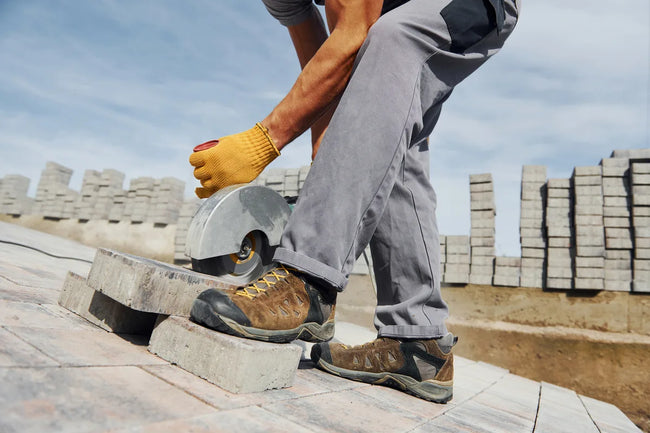
Why wear safety boots in the workplace? Think about it. Would you go to battle without your armor? Of course not! Similarly, you shouldn't venture into a hazardous workplace without proper protective footwear.
Apart from the obvious protection they provide, there are also legal requirements for safety in many industries mandating the use of safety shoes. Ignoring these requirements not only jeopardizes your safety but can also land you in hot water with the authorities.
Why Safety Labels Matter?
Now, let's get down to business. Why should you care about those safety work boot labels plastered on your pair in the first place? Because they're a testament to the protective features of your footwear.
- Protection against workplace hazards: Safety labels act as your guardian angels, alerting you to potential dangers and ensuring you're adequately protected with the right safety-proofed occupational footwear that meets or even exceeds (because, why the heck not?) the demands of your activity or workplace.
- Compliance with safety regulations and standards: Many industries have stringent safety regulations in place, and adherence to these standards is non-negotiable. Safety labels indicate whether your choice of boots meets these requirements.
- Ensuring personal safety and well-being: At the end of the day, it's all about you. Safety labels are there to safeguard your feet from harm, ensuring you go home in one piece. It's that simple.
Understanding Safety Standards & Certifications
Work boots safety standards and certifications are guidelines that ensure the quality and performance of protective footwear for various work environments and hazards. They are developed by organizations such as ASTM International, OSHA, ANSI, CSA (Canadian Standards Association) for Canada, and EN ISO (European Norm International Organization for Standardization) for Europe, who test and evaluate the footwear’s features and capabilities.
For the US markets, we'll focus on:
ANSI/ASTM Standards
The American National Standards Institute (ANSI) and the American Society for Testing and Materials (ASTM) have set the gold standard for safety footwear. These standards outline minimum requirements for impact resistance, compression protection, puncture resistance, and more.
When your boots bear the ANSI/ASTM seal, you can trust they've undergone rigorous testing to keep your feet safe.
- ASTM F2413-18: This document outlines the performance requirements for safety toe cap footwear in the United States, dictating labeling on boots and shoes. It covers aspects such as impact resistance, compression resistance, metatarsal protection, electrical hazard protection, and puncture resistance.
- ASTM F2892: This standard specifies the performance requirements for soft-toe protective footwear in the US, excluding safety or protective toe caps. It focuses on electrical hazard protection and puncture resistance.
- ANSI Z41-1999: Previously the standard for protective footwear in the US, it has been replaced by ASTM F2413 since 2005. However, some footwear may still bear this label. It addresses impact resistance, compression resistance, metatarsal protection, electrical hazard protection, conductive protection, and static dissipative protection.
OSHA Requirements
The Occupational Safety and Health Administration, or simply OSHA, also has your back when it comes to workplace safety. Their regulations stipulate the need for foot protection in various industries. OSHA guidelines influence safety label requirements on work boots, ensuring you're equipped to tackle workplace hazards head-on.
Most Common Types of Safety Labels & Features for Work Boots
Let's break down some of the most common safety labels and features you'll encounter when shopping for a pair of safety work boots:
1. Impact resistance

When heavy objects come crashing down, your boots need to absorb the blow to avoid workplace injuries. Boots labeled with impact resistance (IR) protect your feet from impact in the face of falling debris or rolling objects – a common hazard for workers in various industries, especially construction workers.
It refers to a material’s ability to withstand sudden or intense force or shock and is an important feature of various types of personal protective equipment (PPE), such as safety shoes, work gloves, glasses, etc. The shoe must be able to withstand the impact without allowing too much intrusion into the toe space, which could cause injury.
Different standards, such as ASTM F-2413 safety designation, specify different levels of impact resistance for safety shoes, depending on the work environment and the potential hazards. Safety toe boots that meet the impact resistance requirements are usually labeled with a code that indicates the type and level of protection they offer.
For example, ASTM F2413 I/75 C/75 means the shoe can resist an impact of up to 75 foot-pounds and a compressive load of up to 2,500 pounds.
2. Electrical Hazard Protection
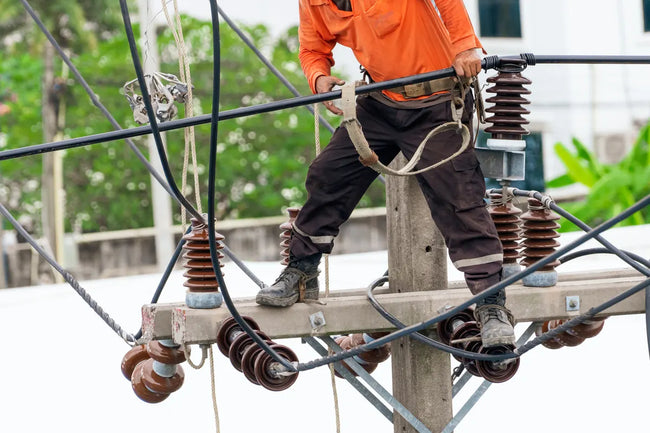
Working around live wires? Electrical Hazard (EH) protection is non-negotiable. These labels indicate that your protective work boots can withstand electrical shocks, keeping you safe from potentially lethal currents. EH protection is achieved by using materials that have low electrical conductivity, such as rubber, leather, or composite materials, to prevent the flow of electricity through the body.
They also have high electrical resistance, which means they do not easily change their electrical properties when exposed to voltage or current. Electrical shock resistance is the ability of a material to withstand a specified amount of voltage without breaking down or causing injury. EH protective work boots must meet the electrical shock resistance requirements of the relevant standards, such as ASTM F2413 EH (protection against open circuits up to 600 volts in dry conditions), and are usually marked with an EH symbol or a green triangle with a white letter E inside.
In some cases, a CSA White rectangle with an orange Greek letter omega - Ω signifies that the soles offer resistance to electric shock – the ability to withstand up to 18,000 Volts without compromising safety and that any leakage current does not exceed 1mA for a duration of 60 seconds.
3. Dielectric Insulation
While safety boots with electrical hazard resistance offer sufficient protection for many workers across various job sites, dielectrically insulated (DI) footwear takes safety to the next level, ensuring an extra layer of protection against electrical charges and hazards.
So, if you're navigating a maze of live wires or working in close proximity to electrical equipment, make sure you choose proper safety footwear equipped with dielectric insulation – it could save your life.
4. Slip Resistance
The "SR" acronym stands for slip resistance. In slippery conditions and wet environments, your workplace safety footwear should be your trusty sidekicks, not your downfall. Boots with slip-resistant soles provide the traction you need to navigate slick surfaces without ending up on your backside. They're often labeled with a grey square symbol with a black “R.”
In the realm of slip-resistance certifications, you'll often encounter three distinct categories: SRA, SRB, and SRC, indicating varying levels of slip resistance, helping you gauge how well your footwear will perform on different surfaces.
For instance, SRA signifies resistance against slip hazards on ceramic tile floors with detergent, SRB indicates resistance on steel floors with glycerol, and SRC combines both SRA and SRB criteria, offering comprehensive protection across multiple surfaces.
5. Puncture Resistance

Nails, shards, and other sharp objects pose a constant threat in many workplaces - that's where sole puncture protection comes in. Boots with puncture-resistant (PR) soles (labeled with a green triangle with “R” in White Circle) act as additional protection, preventing these hazards from piercing through and causing harm, thus reducing the danger of foot injuries to workers.
6. Compression Resistance
Under the weight of heavy machinery, your feet need all the support and extra protection they can get. Compression-resistant (CR) boots distribute pressure evenly, reducing the risk of crushing injuries. Compression resistance is measured by applying a compressive load onto the safety toe boxes and checking the amount of intrusion into the toe space.
The shoe must be able to resist the load without exceeding the maximum allowable intrusion, which could cause injury to the toes. According to the ASTM standards for safety footwear, the level of compression resistance is labeled using the letter C, followed by a number that indicates the level of protection.
For example, C/75 means the shoe can resist a compressive load of up to 2,500 pounds. There are three levels of protection: 30, 50, and 75. Class 75 is the highest level and is recommended for most safety footwear needs.
7. Chemical Resistance
From corrosive substances to caustic chemicals, your boots should stand up to whatever the job throws at them. Chemical-resistant boots keep your feet safe from harmful substances, ensuring you can focus on the task at hand, usually made of PVC, rubber or neoprene. They're ideal for industrial environments like chemical plants, laboratories, oil refineries, and agricultural fields.
8. Metatarsal Protection
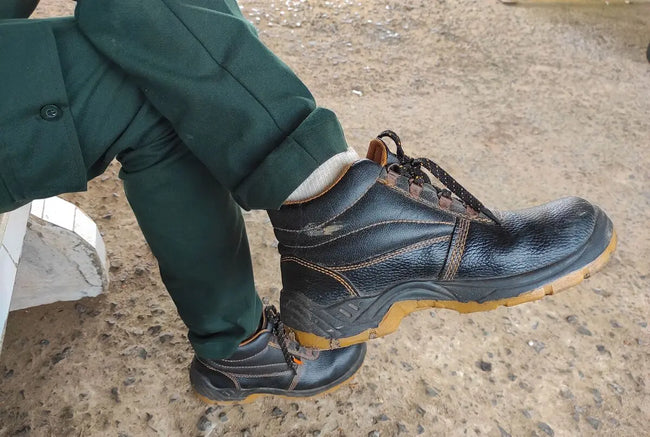
The delicate metatarsal bones in your feet deserve extra TLC. Metatarsal protection (MT) shields this vulnerable area from impact and compression injuries, keeping you on your feet and in the game, especially if you work in heavy industries and construction.
Protective footwear labeled with a Black rectangle donning the letter "M" – will safeguard your metatarsals against potential injuries stemming from the impact of hefty objects.
9. Static Dissipative Properties
In environments where static charges abound, static dissipative boots are your best defense. Dissipative footwear prevents the buildup of static electricity, reducing the risk of sparks and shocks. Keep an eye out for the CSA Yellow rectangle sporting a green "SD+" emblem accompanied by a grounding symbol – it's a telltale sign that the soles are static-dissipative.
These specially crafted soles boast an anti-static protection compound engineered to swiftly neutralize electrostatic charges in a controlled manner. Tested rigorously to meet ASTMF2412 standards, each specimen must demonstrate a resistance falling within the range of 106 Ohms to 3.5 x 107 Ohms. So, when you spot this emblem on your boots, rest assured that they're equipped to keep those pesky static charges at bay, ensuring you stay safe and grounded.
In the ASTM language, static dissipative footwear falls under the ASTM F2413 standard and presents itself in three tiers of protection: ESD 100, ESD 35, and ESD 10 boasting sole resistance levels of up to 100 megaohms, 35 megaohms, and 10 megaohms, respectively.
Tips for Interpreting and Selecting the Right Safety Labels
So, you've got a good grasp of what those safety labels, features, and standards mean – now it's time to put that knowledge to work. Here are some handy tips to help you navigate the world of safety footwear like a pro:
Assess the Specific Hazards in Your Workplace
Not all hazards are created equal, and neither are all safety work boots. Take stock of the specific dangers present in your workplace – whether it's the risk of electrical shocks, heavy objects falling, or slippery surfaces – and prioritize accordingly. Understanding the unique challenges you face is the first step toward selecting the right safety features labeled on your boots.
Consult with Safety Professionals or Supervisors
When in doubt, don't hesitate to seek guidance from those in the know. Safety professionals or supervisors can offer valuable insights based on their experience and expertise. They can help you navigate the complexities of safety regulations and recommend the best footwear options to suit your needs.
Consider Additional Features
While meeting basic safety requirements is essential, don't overlook the potential benefits of additional features. From waterproofing and insulation to heat resistance and ballistic nylon uppers, there are plenty of extras to enhance comfort and performance on the job. Take the time to explore your options and weigh the trade-offs between added features and cost.
Ensure Proper Fit and Comfort
Last but certainly not least, never underestimate the importance of fit and comfort. Even the most protective boots won't do you much good if they pinch your toes or rub against your heels. Take the time to try on different styles and sizes, and pay attention to how they feel on your feet. If shopping online, you can use our sizing guide.
Remember, you'll be spending long hours in these boots, so prioritize comfort as much as safety.
Safety Starts from the Ground Up: Get Familiar with Safety Footwear Labels
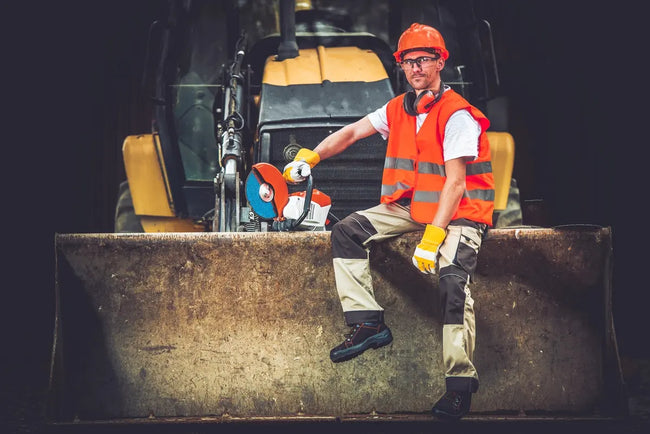
Armed with this knowledge, you'll be ready to tackle the wide range of products in the safety footwear market. Remember, when it comes to workplace safety, there's no such thing as too much protection! In the hustle and bustle of the workplace, safety should never take a backseat.
With the right safety work boots, you're not just investing in footwear – you're investing in your future, your well-being, and your peace of mind. Whether you're navigating construction sites, bustling warehouses, or high-voltage environments, your safety is paramount. Take the first step towards a safer tomorrow and explore the wide range of safety work boots available at Overlook Boots.
We've got your back!
